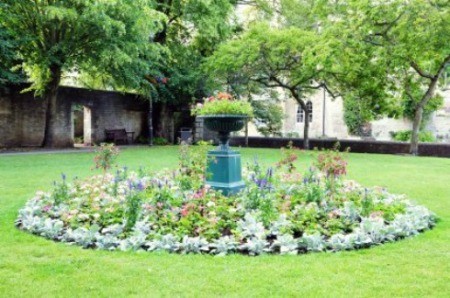Island beds are freestanding garden plots, usually surrounded by grass, which can be walked around and looked at from all sides. When strategically designed, they can provide your landscape with an attractive, colorful focal point. Because the plantings are exposed to light and air on all sides, they tend to grow straight and strong, and are easy to access for maintenance.
Choosing the right location is the key to making an island bed work seamlessly within your landscape. Island beds can be viewed from all sides, so naturally you'll want to start by thinking about how the bed will be viewed. Are you trying to fill in an empty space, enhance an area that lacks interest, or obscure an unpleasant view? Where will you view the bed from most often? If you have a modest sized yard, an island bed can be used to create an optical illusion. Putting an island flower bed in the center of your yard will make it appear larger than if beds are placed around the perimeter. An island bed placed in between your main viewing point and an eyesore will help "stop" the eye. Everything in the landscape has a visual weight. If one side of your yard or garden is "heavy" (e.g. contains a building or large tree), an island bed placed on the opposite side can help create visual balance.
Locations to avoid: Avoid placing an island bed where it will interfere with children playing, foot traffic, or where it will make mowing, watering, and other gardening tasks difficult to complete.
Size: Although island beds can be small, most landscape designers recommend making them as large as space, budget, and maintenance will permit. Here are some basic design principles to keep in mind:
Shape: After you know the maximum width and length of your island bed, you can begin sketching ideas for its shape on paper. For a formal garden, island beds should be regular in shape-square, rectangle, or round. Free-flowing organic shaped beds lend themselves better to a more casual setting. Use a hose or some flour to outline the shape of your bed in the lawn. To get a three-dimensional sense of how the shape and proportions will work, place a few stakes representing your tallest plants in the center of the bed and walk around the bed to view it from all sides.
Island beds look best when you use plants of various heights and colors in an organized way. To develop a planting strategy for your island bed, you need to know the bloom time, color, height, and cultural requirements of each plant you are considering, and then play with them on paper.
After you are finishing planting your island bed, consider installing some type of edging or mowing strip around the perimeter. Edging your island bed serves to define its boundaries from the surrounding lawn. It will also help keep weeds and grass from encroaching on the bed and protect plants from becoming injured when mowing.

About The Author: Ellen Brown is an environmental writer and photographer and the owner of Sustainable Media, an environmental media company that specializes in helping businesses and organizations promote eco-friendly products and services.
Add your voice! Click below to comment. ThriftyFun is powered by your wisdom!